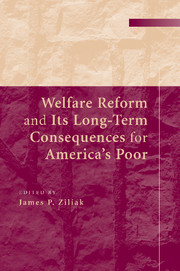Book contents
- Frontmatter
- Contents
- Contributors
- Preface
- Introduction
- 1 What We Know, What We Don't Know, and What We Need to Know about Welfare Reform
- 2 Welfare Reform and the Level and Composition of Income
- 3 How Have Expansions in the Earned Income Tax Credit Affected Family Expenditures?
- 4 How Families Are Doing Nine Years after Welfare Reform: 2005 Evidence from the Three-City Study
- 5 The Impact of Welfare Reform on Leaver Characteristics, Employment, and Recidivism
- 6 A Reexamination of the Impact of Welfare Reform on Health Insurance Among Less-Skilled Women
- 7 How Welfare Policies Affect Child and Adolescent School Performance: Investigating Pathways of Influence with Experimental Data
- 8 The Effects of Welfare and Child Support Policies on the Incidence of Marriage Following a Nonmarital Birth
- 9 Welfare Reform and Health among the Children of Immigrants
- 10 Mismatches and Unmet Need: Access to Social Services in Urban and Rural America
- Index
1 - What We Know, What We Don't Know, and What We Need to Know about Welfare Reform
Published online by Cambridge University Press: 21 January 2010
- Frontmatter
- Contents
- Contributors
- Preface
- Introduction
- 1 What We Know, What We Don't Know, and What We Need to Know about Welfare Reform
- 2 Welfare Reform and the Level and Composition of Income
- 3 How Have Expansions in the Earned Income Tax Credit Affected Family Expenditures?
- 4 How Families Are Doing Nine Years after Welfare Reform: 2005 Evidence from the Three-City Study
- 5 The Impact of Welfare Reform on Leaver Characteristics, Employment, and Recidivism
- 6 A Reexamination of the Impact of Welfare Reform on Health Insurance Among Less-Skilled Women
- 7 How Welfare Policies Affect Child and Adolescent School Performance: Investigating Pathways of Influence with Experimental Data
- 8 The Effects of Welfare and Child Support Policies on the Incidence of Marriage Following a Nonmarital Birth
- 9 Welfare Reform and Health among the Children of Immigrants
- 10 Mismatches and Unmet Need: Access to Social Services in Urban and Rural America
- Index
Summary
It has been more than a decade since major national legislation passed in August 1996, changing the structure of public assistance programs in the United States. During that time period, researchers from many fields have tried to evaluate the various effects of these changes on the behavior and well-being of low-income families. These policy changes have been among the most thoroughly evaluated public policies in history. Yet, it is striking how many questions about the effects of these changes remain unanswered. This chapter summarizes the state of this literature, discussing what we know and what we don't know about the effects of welfare reform.
“Welfare reform” refers primarily to the changes in public assistance programs that were enacted in 1996, particularly the creation of the Temporary Assistance for Needy Families (TANF) block grant. TANF dollars were used by states (along with their own dollars) to fund redesigned cash assistance programs for low-income families that provided much stronger work incentives among recipients. Poor single-mother families were the group predominantly affected by these changes.
But the term welfare reform also is used loosely to refer to a broader set of policy changes. These include the demonstration projects on welfare-to-work efforts within specific states that replaced the then-existing Aid to Families with Dependent Children (AFDC) program. States received federal waivers to enact these programs, which are known as “waiver demonstration projects.”
- Type
- Chapter
- Information
- Publisher: Cambridge University PressPrint publication year: 2009
- 13
- Cited by



